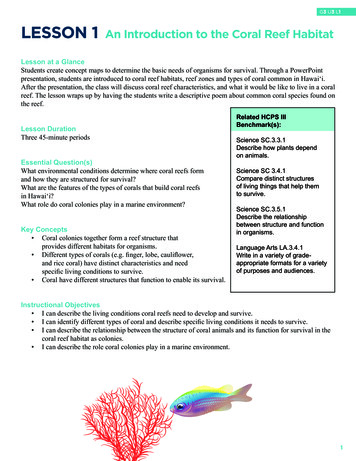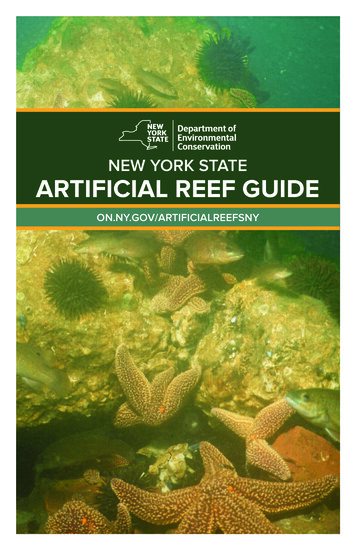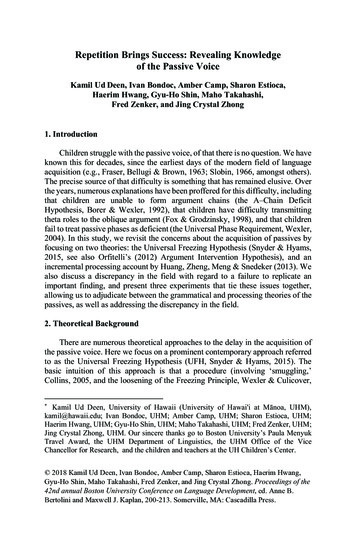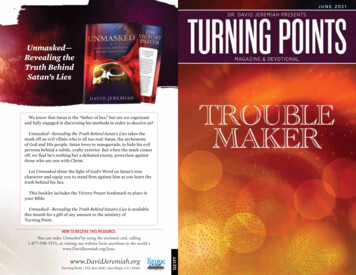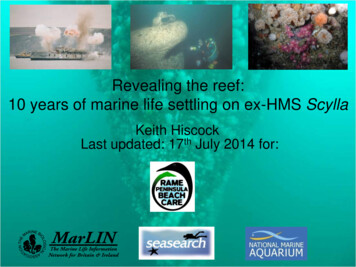
Transcription
Revealing the reef:10 years of marine life settling on ex-HMS ScyllaKeith HiscockLast updated: 17th July 2014 for:
The presentation: How Scylla was before sinking on 27 March 2004. The ‘time-line’ of marine life settlement. How you can help maintain records from Scylla –and get involved in reporting marine lifeobservations.(All with thanks to: Plymouth Sound BS-AC; MCS local group especiallyAmy Bugg; Sally Sharrock; Peter Messenger; University of PlymouthDiving Centre, Unicomarine for identification of samples, and manyothers for the diving, the marine life records and the use of images.And, of course, the National Marine Aquarium with the Canadian ArtificialReefs Consortium for putting Scylla on the seabed - right-way-up.)(Background image: The bow of Scylla on 26th February 2009)
19th November 2003.DevonportScylla was brought fromPortsmouth to Devonport whereshe arrived on 18 November2003. The next morning, thewater had drained from the drydock and the vessel was readyto be prepared for sinking.The work of obtaining the licenceto place her on the seabed,preparing the vessel andoverseeing the project wasundertaken by the NationalMarine Aquarium in Plymouthafter many years of work tosecure a vessel and sink it bythe Artificial Reef Consortium.
Inspection of existingfoulingPart of the licence to place thevessel on the seabed was tocatalogue the fouling organismspresent on the vessel on arrivalfrom Portsmouth: a taskundertaken by staff from theMarine Biological Association inPlymouth.The survey listed species anddiscovered just how effectiveexisting anti-fouling paint was –significant areas of the hull werebare of fouling.
Oysters, sponges,barnacles etc. onone of the propellersA tantalizing view of one of thetwo propellers – removed aspart of the preparation forsinking. The attached faunaincluded, surprisingly, severalnative oysters as well assponges, barnacles and manydahlia anemones.
27 March 2004The vessel was towed to a predetermined and licensed site in Whitsand Bay andstrategically placed explosives were detonated to sink the vessel. The vessel hadto sink quickly (within 3 minutes) to avoid oscillations and tipping. There wereanxious moments as she lent over a little to starboard and great relief when shelanded right way-up with only a slight list to starboard – where she has remainedever since.www.national-aquarium.co.uk
Scylla. In the first year:1. a small numbers of potentially resident fish (poor cod) wereattracted after about 10 days;2. colonisation by barnacles, tube worms, Obelia hydroids andmicrobial slime occurred within about four weeks;3. ‘wandering’ species found the reef (spiny starfish, spinyspider crabs, long-spined sea scorpion etc.);4. barnacles, tube worms and Obelia hydroids becamecommon at about 6-7 weeks and were joined by Tubulariahydroids and, on shallow parts, brown filamentous algae;5. by ten weeks after placement, the variety of organisms wassignificant and kelp, solitary sea squirts, anemones etc. hadsettled.
Colonisation by microbial slime,barnacles, tube worms and Obeliahydroids had occurred within about fourweeksFirst observed and image: 23 April 2004Barnacles, Balanus crenatusFirst observed and image: 23 April 2004Tube worms, Pomatoceros triqueter
First observed: 12 May 2004; Image: 9 June 2004Brown filamentous algae were profuse during the spring and before grazing speciesarrived in significant numbers.
First observed: 12 May 2004; Image: 25 June 2004‘Wandering’ species found the reef from the surrounding seabed. Here, the spinystarfish, Marthasterias glacialis. Other species settled from their larvae in theplankton. Here, sea squirts, Ciona intestinalis.
Scylla. In the first year (continued):6. by 18 weeks, a wide variety of species including a masssettlement of juvenile queen scallops, many ‘decorata’anemones, extensive growths of Tubularia hydroids, a varietyof algae etc. Mussels were settling. Tube worms and solitarysea squirts cover some surfaces. Algae abundant on uppersurfaces;7. by 24 weeks, green urchins and common starfish hadsettled in large numbers;8. by 30 weeks, juvenile queen scallops were abundant overand in the vessel. Green urchins and common starfish nowabundant and largish.
First observed: 26 July 2004; Image: 30 July 2004Queen scallops settle. The scallop is only about 8 mm across.
Image: 18 February 2005Queen scallop, Aequipecten opercularis inside the vessel. Most of the scallopsprobably left the reef for their usual habitat on level sediments after the summer,although some stayed inside the reef on decking. This one was about 30 mm across.
First observed: 30 July 2004; Image: 30 July 2004One of the earliest ‘surprise’ colonists was the seaanemone that rejoices in the name Sagartia troglodytesvariety decorata. However, speaking to ancient marinebiologists it turns out “Oh yes, they were always one ofthe first things to settle on new surfaces.” (Picture widthabout 50 mm.)
First observed: 12 May 2004; Image: 9 June 2004Tubularia hydroid. Tubularia (this Ectopleura larynx) hydroids live where water currentsare strong and were one of the first colonisers. They are very pretty to photograph –but catch them in the spring before the sea slugs eat them.
First observed: 9 June 2004; Image: 9 June 2004Encrusting sea mat, Electra pilosa. Another early coloniser - on the fabric coveredceiling of the bridge
First observed: 9 June 2004; Image: 30 July 2004Solitary sea squirts, Ciona intestinalis. A ‘classic’ early settler and a ‘classic’ solitarysea squirt. You can see the two siphons – one takes in water which is sievedinternally and then passed-out through the other.
First observed: 25 June 2004; Image: 30 July 2004Brown alga, Cutleria multifida. OK, so brown seaweeds are not very exciting orpretty but most have quite short-lived spores so it’s interesting to see which onesmade it to the vessel early and this is one.
First sampled and recorded: 30 July 2004; Image: 30 July 2004Filamentous red algae. Seaweeds that settled early on. However, for the first twoyears, the variety of seaweed species was low.
First observed: 26 June 2004; Image: 30 July 200430 July 2004Sea slug Facelina bostoniensis and eggs. Very pretty – but it eats Tubularia hydroids.The white spiral is the egg mass.
25 September 2004. The bow.By end of the first summer: dense colonisation – but the urchins and starfish havesettled. Remember this picture for a later image – it shows the high level of colonisationby the end of the first summer – still none of the ‘classic’ steel wreck species.
First observed: 26 July 2004; Image: 10 November 2004From mid summer to autumn, there were mussels – but starfish eat mussels.Image: Sally Sharrock
Scylla. In the first year (continued)By midwinter (40-48 weeks):9. green sea urchins together with normal seasonal declinehave removed algal growth as well as much barnacle andtube worm cover;10. common starfish have removed mussels, barnacles and,no doubt, other species;11. the reef looks ‘bare’;12. plumose anemones are reproducing (by basal laceration)and are becoming visually dominant near the bow;13. calcareous sponges have settled;14. corkwing wrasse observed ‘holding territory’.
First observed: 25 September 2004; Image: 18 February 2005Green sea urchin Psammechinus miliaris. If you were a barnacle, tube worm, seaweedor most other encrusting species, you should be pretty scared of this beast – and therewere thousands of them. But, a species that you never normally see underwater on theopen coast in south-west England – you have to look under boulders on the shore tofind them. So, why are they on Scylla? Looks scary but only about 40 mm across.
First observed: 25 September 2004; Image: 18 February 2005Common starfish, Asterias rubens. Starfish are voracious predators and, oncesettled on Scylla, they grew quickly. They will eat mussels, barnacles and anythingthey can get into.
18 February 2005Cleaned by urchins & starfish. Towards the end of the first winter, Scylla was lookingwell-cleaned. You can see the fairly evenly distributed starfish and urchins on thevertical surface below the windows.
First observed: 25 September 2004; Image: 18 February 2005Almost one year on from placement, changes were happening that would build thecommunity that would be the long-term ‘look’ of Scylla. A ‘classic’ wreck species is theplumose anemone. They settle from planktonic larvae and then carry on reproducingby ‘basal laceration’. You can see offspring that have split-off to the right of the adult.
First observed: 30 January 2005; Image: 30 January 2005Corkwing wrasse on the starboard walkway. Wrasse were extremely slow to colonisethe reef. However, as early as January 2005, a small number were present. Itseemed that it would take a long time for numbers to build to the sort of abundanceon the nearby James Egan Layne.
Scylla. In the first year (continued)By the end of and after one year (50-55 weeks):15. much of vessel still very bare (grazed);16. but, algae have returned;17. common starfish declining and green sea urchins possiblyless abundant.
19 March 2005Compare this view of the bow with the one taken in September 2004 – a combinationof winter die-back but predominantly grazing has left the bow ‘clean’ where it hadbeen densely colonised.
By the end of one year, we had:1. recorded (through the year and from various sources) atotal of 53 conspicuous species on or in Scylla (excludingsurrounding seabed species);2. been able to track sequence of species colonisation (andloss) through the year;3. had a few surprises (unexpected settlements).
In the second year (2005):losses and gains1. Grazing much less (sea urchins decline dramatically,starfish less abundant).2. Some significant new species settle.3. Plumose anemones become visually dominant in manyareas.4. In the reduced grazing regime, tubeworms, barnacles andfoliose algae thrive.
15 July 2005Urchin midden (wrasse had ‘discovered’ Scylla). Back to the scary green sea urchins– this is what happens when wrasse find them! So, on the open coast where there arelots of wrasse, the urchins are unlikely to survive and during the second year of Scylla,their numbers plummeted.
7 September 2005During the spring and summer of the second year, algae colonised the foredeck –but a small variety of filamentous species.
First observed: 9 August 2005 (but see next image); Image: 7 September 2005Jewel anemones settled in 2005
First observed: 10 June 2005; Image: 15 July 2005Dead men’s fingers have a planktonic larvae which should have been ‘about’ whenthe vessel was sunk but settled individuals only appeared in the second year. Thisone probably settled in April 2005 and is, in July, the size of your thumb nail.
First observed: 10 June 2005; Image: 7 October 2006Sagartia elegans rosea. Lots of very pretty ‘elegant’ anemones settled in 2006. Thisone is about 30 mm across.
18 August 2006Dead men’s fingers were common by late summer 2006 and nearly full grown (andmore have settled). Watching Scylla helps us to understand how quickly differentspecies grow to full size.
28 January 2006Beginning to look like what would be expected on a wreck: Plumose anemones onthe propellor shaft.
During the winter 2005-6 and into 2006,visually dominant species expanded andthe reef communities began to stabilize.1. Plumose anemones became abundant in some areas2. Dead man’s fingers became common and grew to full sizeBut still room for more – especially inside
28 January 2006Still plenty of room inside
First observed: 25 March 2006; Image: 25 March 2006Ross, Pentapora foliacea. One of the species that was expected to settle. The colonyis small (only about 50 mm across) and is very fragile – perhaps not much of a chanceof survival with all those clumsy finners.
First observed: 28 January 2006; Image: 30 August 2006Sea beard, a common species on wrecks but not seen until winter 05/06
10 July 2013Sea beard, now a common species on Scylla, dominating some decks
First observed: 9 June 2006; Image: 18 August 2006Top of the reef colonised by ‘expected’ variety of seaweeds including kelp
20 August 2006Foredeck colonised by ‘expected’ variety of foliose seaweeds
20 August 2006Lots more fish by end of summer 2006 – scad off the bow
20 August 2006The scallops are back! (but not so many)
18 August 2006Many parts of the outside of the reefs are ‘solid’ with colonisation and a wide variety ofspecies
Well, maybe. The tributyl tin antifouling paint (more than about 15 years since it waslast applied when Scylla was sunk) is still remarkably effective. Such paint is greatlydamaging to marine life and has been banned from use on small vessels since 1986. Itis no longer used on RN vessels and has been banned from all vessels after 2008.(The black lines are ‘divers lines’ and are not treated – used for navigation during hullinspection.)
26 February 2009Topknot ‘braving’ the anti-fouling paint under the stern (and trying their best to mimicthe colour).
By end of August 2006 (from our ‘Wanted’list of spring 2005 & before ‘Scylla week’):First seenJune 2005White sea fingersFirst seenMarch 2006RossStill lookingRed sea fingersStill lookingEdible sea urchinFirst seenSept 2005Devonshire cup coralsStill lookingPink sea fan126 species recorded from Scylla fromobservations and photographs
30 August 2006 and during the subsequent ScyllaWeekTo discover what is living inthe undergrowth and underthe silt on horizontal surfaces,samples are needed. Here,an air-lift suction sampler thatis used just like anunderwater vacuum cleanerwith the beasties beingcaught in a net inside thesample chamber.
The contents of a suction sample from the foredeck. Inamongst the conspicuous species are amphipod shrimps,worms and much else. About 84 additional species wereidentified from samples taken during Scylla Week, bringingthe total number of species identified on Scylla to about 220.
By the end of 2006, most of the speciesthat were to be visually dominant on thereef had settled.But those species had to expand inabundance and grow in size beforeScylla would qualify as hosting a ‘maturesteel wreck community’.And some ‘expected’ species were stillunaccounted for.
First observed: 27 April 2007; Image: 27 April 2007After some false sightings (there are brown dead man’s fingers), red sea fingers,Alcyonium glomeratum, were first seen on 27th April 2007.
First observed:28 July 2006; Image: 17 August 2007Orange pumice bryozoan, Cellepora pumicosa were first observed in summer 2006and, unexpectedly, became extremely abundant in the next year.
15 June 2007By summer 2007, established species characteristic of wrecks were growingtowards full size: dead man’s fingers, ross and orange pumice bryozoans wereabundant
First observed: 30 September 2007; Image: 19 September 2008Sea urchins, Echinus esculentus were not reported from the reef until 30 September2007 (often, small ones hide during day in crevices)
First observed: 12 August 2007; Image: 10 December 2008Sea fans, Eunicella verrucosa, are abundant and form ‘forests’ on many of the steelwrecks out of Plymouth. They occur on rock reefs as little as 40m away from Scyllabut did not settle on Scylla until its 4th year (2007). The largest one measured at theend of 2008 was 17cm high but there were also lots of individuals only 1 cm high –probably from a 2008 settlement.
First observed: 25 September 2004; Image: 19 September 2008Feather stars, Antedon bifida, were first observed in September 2004 with manyjuveniles present in September 2007. However, they only became abundant as largeindividuals in 2008 and were particularly conspicuous inside the vessel on spars andon the gridded area of the helideck.
10 December 2008There are significant seasonal changes on Scylla – a winter scene with few algae onshallow decks. Expect die-back of many organisms but especially the foliose algaeduring winter. February is a particularly ‘low’ period before the spring outburst ofgrowth and settlement starts.
10 December 2008The ‘shows’ of oaten pipe hydroids (there are two species often mixed together)are spectacular but ephemeral because of depredations by sea slugs and aswinter die-back occurs. This image was captured in December; by the end ofFebruary the following year, only one or two solitary live hydranths could be found.
26 February 2009Spring growth beginning – sea beech Delesseria sanguinea
By end of March 2009 (from our ‘Wanted’list of spring 2005 and after ‘Scylla week’):First seenJune 2005Dead man’s fingersFirst seenMarch 2006RossFirst seenApril 2007Red sea fingersFirst seenSept 2007Edible sea urchinFirst seenSept 2005Devonshire cup coralsFirst seenAugust 2007Pink sea fan263 species recorded from Scylla fromobservations, photographs and samples
By March 2009, five years after placement, Scylla hosted a mature steel wreck marinelife community. “Alcyonium digitatum and Metridium senile on moderately waveexposed circalittoral steel wrecks” is one of about 350 ‘biotopes’ (habitats and theirassociated species) classified from around Britain and Ireland.
However, the number of wrasse on the reef has increased very slowly and still hasto reach that of established wrecks.Rock cook (and pollack) on 10th July 2013.
It was now time tobring togetherrecords ofcolonisation and topublish the results(in February 2010).
There are still changes occurring. For instance, the abundance of solitary seasquirts has greatly declined and there was a large settlement of mussels in 2012which was rapidly consumed by the common starfish now resident on the reef.
By the end of thesummer of 2013, theplants and animalsinhabiting Scylla weremostly those that hadsettled by the end of2007 and the speciescount for the reef stoodat 278.Starboard side, near the bridge. 12th October 2013
After the winter storms of 2014: some loss of wildlife but most is‘as always’GoneStarboard side, near the bridge.12th October 2013Starboard side, near the bridge.23rd April 2014
After the winter storms of 2014: some damage especially insidebut most is ‘as always’23rd April 2014
The future?Plenty of life in the old girl yet but .
Visit Scylla! Scylla continues to provide opportunities forexcellent recreational diving on a reef smothered in marine life
Recording of the marine life on Scylla is now mainly throughobservations by recreational divers. Do report and photographanything unusual that you see or just want to put a name to.
And, finally, enjoy Scylla but pay attention all divers (and fish):
Report any unusual or interesting marinelife (supported by images where possible):www.mba.ac.uk/recording24 hr reporting hotline:01752 633291E-mail images to: recording@mba.ac.ukGet this presentation: www.marlin.ac.uk/scyllaJoin-up: www.mcsuk.org; www.seasearch.org.uk; www.mba.ac.uk
3. 'wandering' species found the reef (spiny starfish, spiny spider crabs, long-spined sea scorpion etc.); Colonisation by microbial slime, barnacles, tube worms and Obelia hydroids had occurred within about four . green urchins and common starfish had settled in large numbers; Queen scallops settle. The scallop is only about 8 mm across.

